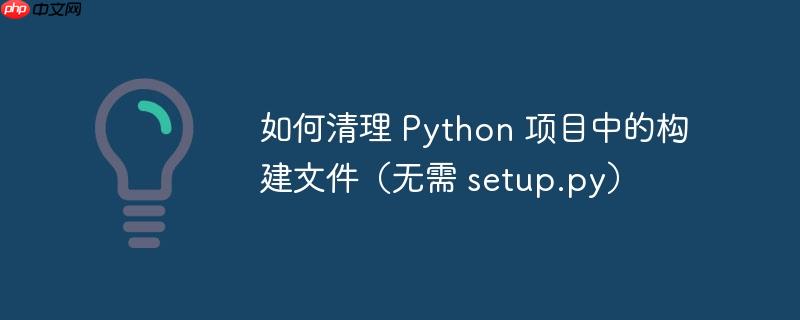高效使用Python的for循环需理解其迭代器机制,利用列表推导式提升性能,结合enumerate获取索引,用range控制循环次数,善用break和continue控制流程,并避免修改被遍历列表等常见错误。

Python中的
for
for
如何高效使用Python的for循环?
for
for
enumerate
解决方案:
-
基本语法
循环的基本语法如下:for
for item in iterable: # 执行代码块- :循环变量,用于存储可迭代对象中的每个元素。
item
- :可迭代对象,如列表、元组、字符串、字典、集合等。
iterable
-
循环列表
fruits = ["apple", "banana", "cherry"] for fruit in fruits: print(fruit)输出:
apple banana cherry
-
循环字符串
message = "Hello" for char in message: print(char)输出:
H e l l o
-
循环字典
student = {"name": "Alice", "age": 20, "major": "Computer Science"} for key, value in student.items(): print(f"{key}: {value}")输出:
name: Alice age: 20 major: Computer Science
-
使用
函数range()
函数用于生成一个数字序列,常用于循环指定次数。range()
for i in range(5): # 生成 0, 1, 2, 3, 4 print(i)输出:
0 1 2 3 4
-
和
break
语句continue
- :用于提前终止循环。
break
- :用于跳过当前循环迭代,继续下一次迭代。
continue
numbers = [1, 2, 3, 4, 5] for num in numbers: if num == 3: break # 终止循环 print(num)输出:
1 2
numbers = [1, 2, 3, 4, 5] for num in numbers: if num == 3: continue # 跳过当前迭代 print(num)输出:
1 2 4 5
-
子句
else
循环可以有一个可选的for
子句,它在循环正常结束后执行(即不是通过else
语句终止的)。break
numbers = [1, 2, 4, 5] for num in numbers: if num == 3: print("Found 3") break else: print("3 not found")输出:
3 not found
如何避免Python for循环中的常见错误?
初学者容易犯一些错误,比如修改循环中的列表导致索引错乱,或者在不理解迭代器的情况下使用
for
-
索引越界
- 问题:在循环中尝试访问超出列表范围的索引。
- 解决方案:确保循环变量在有效索引范围内。
my_list = [1, 2, 3] for i in range(len(my_list)): print(my_list[i]) # 正确 # for i in range(len(my_list) + 1): # 错误:会导致索引越界 # print(my_list[i]) -
修改循环中的列表
- 问题:在循环过程中修改列表,可能导致循环行为异常。
- 解决方案:如果需要修改列表,可以创建一个新列表。
my_list = [1, 2, 3, 4, 5] new_list = [] for item in my_list: if item % 2 == 0: new_list.append(item * 2) print(new_list) # 输出 [4, 8] -
不正确的迭代器使用
-
问题:尝试在不支持迭代的对象上使用 循环。
for
- 解决方案:确保对象是可迭代的。
# my_number = 123 # 错误:整数不可迭代 # for digit in my_number: # print(digit) my_string = "123" # 正确:字符串可迭代 for digit in my_string: print(digit) -
问题:尝试在不支持迭代的对象上使用
-
忘记冒号
-
问题:语句末尾忘记添加冒号
for
。:
-
解决方案:始终在 语句末尾添加冒号。
for
my_list = [1, 2, 3] for item in my_list: # 正确 print(item) # for item in my_list # 错误:缺少冒号 # print(item) -
问题:
如何利用Python for循环进行数据处理和分析?
在数据处理领域,
for
if
for
for
-
数据过滤
- 场景:从数据集中筛选出符合特定条件的元素。
- 示例:
data = [1, 2, 3, 4, 5, 6, 7, 8, 9, 10] filtered_data = [] for item in data: if item % 2 == 0: # 筛选偶数 filtered_data.append(item) print(filtered_data) # 输出 [2, 4, 6, 8, 10] -
数据转换
- 场景:将数据集中的元素进行转换,生成新的数据集。
- 示例:
data = [1, 2, 3, 4, 5] squared_data = [] for item in data: squared_data.append(item ** 2) # 计算平方 print(squared_data) # 输出 [1, 4, 9, 16, 25] -
数据聚合
- 场景:将数据集中的元素进行聚合,计算总和、平均值等。
- 示例:
data = [1, 2, 3, 4, 5] total = 0 for item in data: total += item # 计算总和 average = total / len(data) # 计算平均值 print(f"Total: {total}, Average: {average}") # 输出 Total: 15, Average: 3.0 -
读取文件数据
- 场景:从文件中读取数据,并进行处理。
- 示例:
with open("data.txt", "r") as file: for line in file: line = line.strip() # 去除行尾空格 print(line)如果
文件包含以下内容:data.txt
apple banana cherry
输出:
apple banana cherry
-
数据分析示例:统计词频
- 场景:统计文本中每个单词出现的次数。
- 示例:
text = "this is a test string this is a string" words = text.split() word_counts = {} for word in words: if word in word_counts: word_counts[word] += 1 else: word_counts[word] = 1 print(word_counts) # 输出 {'this': 2, 'is': 2, 'a': 2, 'test': 1, 'string': 2}
以上就是python怎么用for循环_python循环语句入门教程的详细内容,更多请关注资源网其它相关文章!




发表评论:
◎欢迎参与讨论,请在这里发表您的看法、交流您的观点。